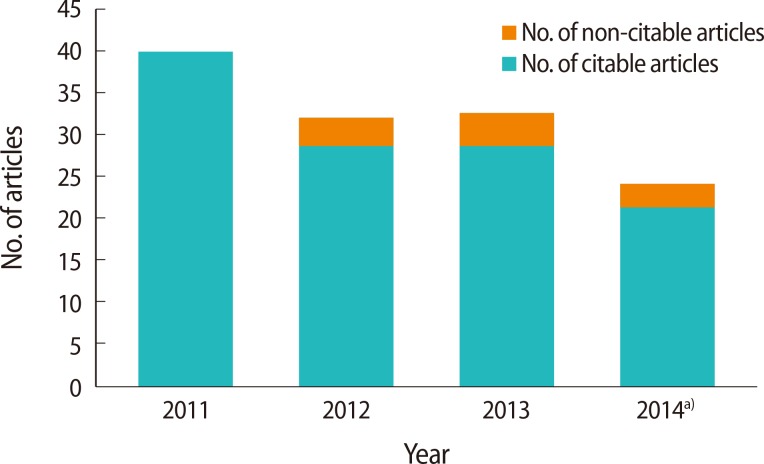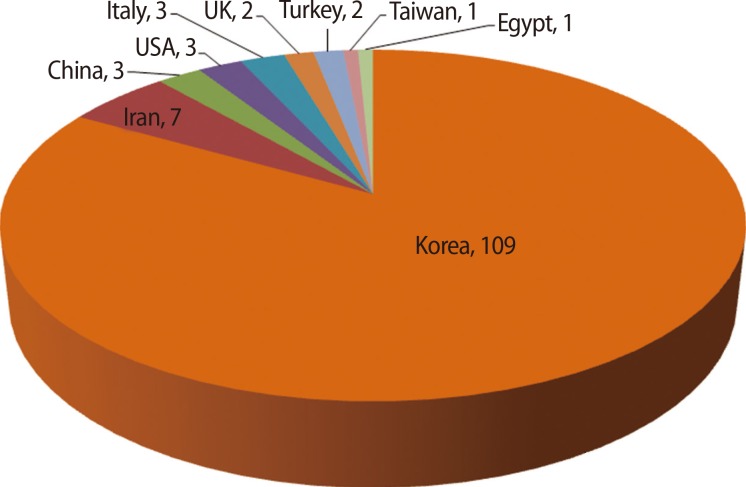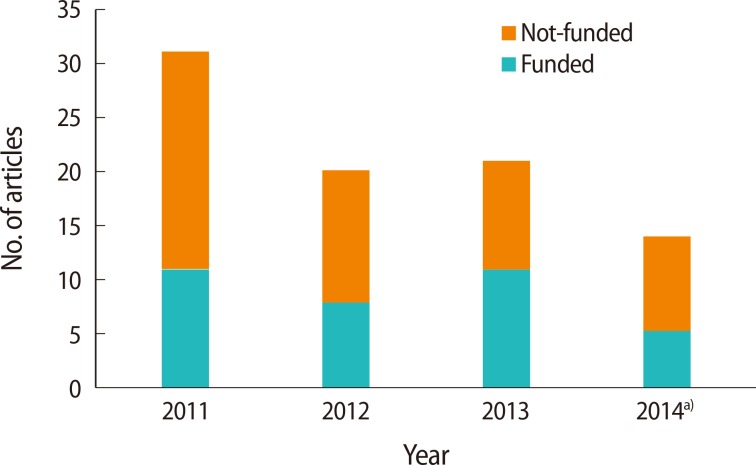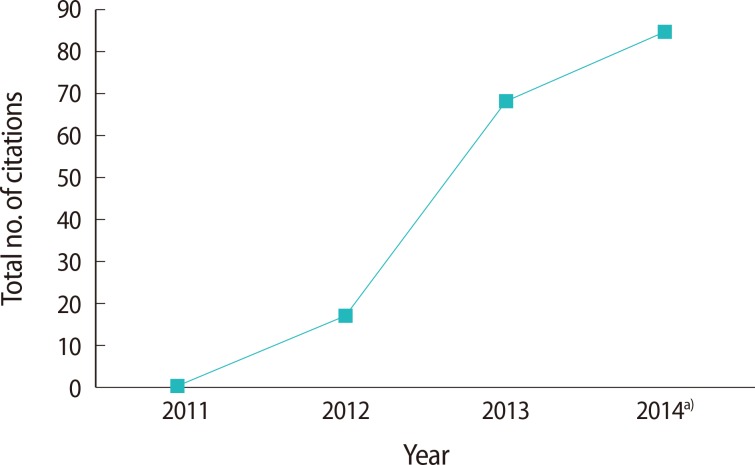 |
 |
- Search
| Clin Exp Reprod Med > Volume 41(4); 2014 > Article |
Abstract
Objective
Clinical and Experimental Reproductive Medicine (CERM) converted its language to English only beginning with the first issue of 2011. From that point in time, one of the goals of the journal has been to become a truly international journal. This paper aims to identify the position of CERM in its scholarly journal network based on the journal's metrics.
Methods
The journal's metrics, including citations, countries of author affiliation, and countries of citing authors, Hirsch index, and proportion of funded articles, were gathered from Web of Science and analyzed.
Results
The two-year impact factor of 2013 was calculated at 0.971 excluding self-citation, which corresponds to a Journal Citation Reports ranking of 85.9% in the category of obstetrics and gynecology. In 2012, 2013, and 2014, the total citations were 17, 68, and 85, respectively. Authors from nine countries contributed to CERM. Researchers from 25 countries cited CERM in their articles. The Hirsch index was six. Out of 88 original articles, 35 studies received funds (39.8%).
Clinical and Experimental Reproductive Medicine (CERM) is an official journal of the Korean Society for Reproductive Medicine and Korean Society for Assisted Reproduction. The aims of CERM are to publish high quality articles that facilitate the improvement of the current diagnosis and treatment in couples with reproductive abnormalities through human or relevant animal model research. Its scope is infertility, reproductive endocrinology, urology, andrology, the developmental biology of gametes and early embryos, basic reproductive science, reproductive physiology, reproductive immunology, genetics, and biology of stem cells (http://ecerm.org/).
CERM was launched in 1974 with a Korean title translated as Journal of Fertility and Sterility. It continued as Korean Journal of Reproductive Medicine from issue 2 of 2007. In 2011, the language of the journal was changed to English only with the present journal title. The purpose of the language change was to enable the propagation of the journal content to international researchers, physicians, health personnel, and patients and their families, not only for research development but also for the promotion of human health. Four years have passed since the language was changed. Now it is time to reflect upon the effect of the conversion to English publication; therefore, CERM's metrics were analyzed here, and the position of the journal in the scholarly journal network was elucidated.
The following data from the first issue of CERM in 2011 to the September issue of 2014 were gathered: number of citable and non-citable articles per year; countries of the aut hors; and proportion of articles funded out of the total number of original articles. Journal metrics from the Web of Science were analyzed as follows: impact factor; total citations; countries of the authors who cited CERM; Hirsch index (h-index); and publication types of highly cited articles. The calculation methods and definitions were the same as those previously described one [1,2]. The h-index of six other PubMed Central journals from Korea that were added in 2012 with a title change was also calculated from Web of Science and compared with that calculated for CERM. Additionally, to compare the effect of the journal language, the total citations of the Korean Journal of Fertility and Sterility and the Korean Journal of Reproductive Medicine, the former titles of CERM, published from 1974 to 2010 was calculated from Web of Science. The percentage of English papers was counted for the two former titles of CERM.
The number of citable and non-citable articles per year in CERM is presented in Figure 1. Out of 127 articles, 118 were citable and nine non-citable. The authors' affiliations included nine countries. Among the articles, 109 out of 127 were from Korea. The other countries of the authors were Iran, China, the Unites States, Italy, the United Kingdom, Turkey, Taiwan, and Egypt (Figure 2). The proportion of articles funded out of the total number of original articles is presented in Figure 3. Out of 88 original articles, 35 (39.8%) were funded. The 2013 Journal Impact Factor calculated from Web of Science was 0.971. This corresponds to the 67th ranking out of 85 journals listed in the 2013 Journal Citation Reports Obstetrics and Gynecology category (upper 85.9%). If self-citation is included, it was 1.028. The total citations in the Web of Science increased year by year exponentially. In 2012, 2013, and 2014, the total citations were 17, 68, and 85, respectively (Figure 4).
Countries of the authors who cited CERM in the Web of Science are presented in Figure 5. The number of countries of citing authors is 25. Based on the Web of Science, the h-index was six since number of papers cited at least six times were equal to six. Of the seven highly cited articles, five were reviews and two were original articles (Table 1). The percentage of English papers was as follows: from the Korean Journal of Fertility and Sterility (1991-2007 March), 51 (10.3%) of 498, and from the Korean Journal of Reproductive Medicine (2007 June-2010 December), 19 (14.6%) of 130 papers were in English. There was no publication content available online for the period from 1974 to 1990. The total number of citations of the Korean Journal of Fertility and Sterility during its 34 years of publication was 28. The total number of citations of the Korean Journal of Reproductive Medicine during its five years of publication was seven.
The transition in CERM's journal metrics that accompanies its change in language is dramatic. CERM became a journal highly cited internationally within a short period. Since the total number of citations of the Korean Journal of Fertility and Sterility and Korean Journal of Reproductive Medicine over the course of 37 years of publication was only 35, but the number of citations of CERM in less than four full years was 170, the decision to change the language of the journal to English only was clearly successful based on the journal metrics. It can be deduced that the former titles had not been given the attention their content deserved due to the language barrier. The proportion of English papers of the former titles was below 15%. Because CERM was first included in PubMed Central and PubMed from March 2, 2012, this was the turning point for its exposure to international researchers in the field of reproductive medicine. It was possible to be included in PubMed Central because CERM accepted an open access policy according to a Creative Commons license [3]. From May 2012, CERM was also included in SCOPUS.
It is well-known that the impact factor and total citations increase rapidly after a journal is included in PubMed Central [4,5], and after depositing Journal Article Tag Suite Extensible Markup Language (JATS XML) files [6,7]. The deposit of CrossRef XML to allow for the connection to the international journal network through the digital object identifier system can also be an invaluable contribution [8,9]. Not only the diversity of authors' countries of affiliation but also the diversity of citing authors' countries demonstrates that CERM is establishing itself as an international journal. The same phenomena can be seen for other English-language journals published in Korea, such as Archives of Plastic Surgery [10], International Neurourology Journal [11], Diabetes & Metabolism Journal [1], Korean Journal of Internal Medicine [12,13], Korean Journal of Urology [2], and Journal of Educational Evaluation for Health Professions [14].
The h-index of six is still not a high value. This may be due to the small number of articles and short period of exposure to researchers internationally. The h-index of the other journals from Korea added to PubMed Central in 2012 with a title change are comparable: Annals of Rehabilitation Medicine, 6; Knee Surgery and Related Research, 4; Clinical Endoscopy, 6; Archives of Plastic Surgery, 6; Safety and Health at Work, 5; and Radiation Oncology Journal, 4. It appears that the h-index is growing at about the same rate among the journals from Korea that changed languages and were included in PubMed Central at the same time. The publication type of highly cited articles is usually the review article. In CERM, although reviews were a predominant article type out of the seven highly cited articles, original articles received most citations. This phenomenon in CERM is unusual; therefore, it can be concluded that high quality original articles also receive frequent citations in this field of study.
To further promote CERM as an international journal and better expose it to researchers performing meta-analyses and systematic reviews, inclusion in the text and data mining (TDM) service provided by CrossRef is required in the near future [15]. TDM is a new service, introduced in May 2014.
In conclusion, it is worth noting that CERM has reached the status of an international journal based on its journal metrics. The change of the journal's language from Korean to exclusively English was an important leap toward its goal of becoming a prestigious journal. CERM will continue to attract researchers worldwide based on its unique aims and scope and its open access policy.
Notes
References
1. Huh S. Journal metrics-based position of Diabetes & Metabolism Journal after the change of its text language to english. Diabetes Metab J 2014;38:187-193.PMID: 25003071.



2. Huh S. Citation analysis of the Korean Journal of Urology From Web of Science, Scopus, Korean Medical Citation Index, KoreaMed Synapse, and Google Scholar. Korean J Urol 2013;54:220-228.PMID: 23614057.



4. Jeong GH, Huh S. Increase in frequency of citation by SCIE journals of non-Medline journals after listing in an open access full-text database. Sci Ed 2014;1:24-26.

5. Huh S. Why should Neurointervention be indexed in International Databases? Neurointervention 2011;6:49-50.PMID: 22125749.



6. Huh S. Journal Article Tag Suite 1.0: National Information Standards Organization standard of journal extensible markup language. Sci Ed 2014;1:99-104.

7. Huh S. Coding practice of the Journal Article Tag Suite extensible markup language. Sci Ed 2014;1:105-112.

8. Lammey R. CrossRef developments and initiatives: an update on services for the scholarly publishing community from CrossRef. Sci Ed 2014;1:13-18.

9. Lammey R. Practice of CrossRef extensible markup language coding and more advanced information for CrossRef deposits. Sci Ed 2014;1:91-98.

10. Huh S. How journal metrics illustrate the transformation of archives of plastic surgery into an international journal. Arch Plast Surg 2014;41:617-619.PMID: 25396171.



11. Huh S. How far has the International Neurourology Journal progressed since its transformation into an english language journal? Int Neurourol J 2014;18:3-9.PMID: 24729921.



12. Huh S. Citation analysis of The Korean Journal of Internal Medicine from KoMCI, Web of Science, and Scopus. Korean J Intern Med 2011;26:1-7.PMID: 21437155.



13. Huh S. How far has The Korean Journal of Internal Medicine advanced in terms of journal metrics? Korean J Intern Med 2013;28:635-638.PMID: 24307835.



14. Huh S. Revision of the instructions to authors to require a structured abstract, digital object identifier of each reference, and author's voice recording may increase journal access. J Educ Eval Health Prof 2013;10:3PMID: 23755319.



Figure┬Ā1
Citable and non-citable articles in Clinical and Experimental Reproductive Medicine according to year. a)March to September issues of 2014.

Figure┬Ā2
Countries of authors and corresponding number of articles of Clinical and Experimental Reproductive Medicine from 2011 to September 2014.

Figure┬Ā3
Proportion of funded articles of Clinical and Experimental Reproductive Medicine according to year. a)March to September issues of 2014.

Figure┬Ā4
Total citation of Clinical and Experimental Reproductive Medicine according to year from 2011 to end of October 2014. a)March to September issues of 2014.









